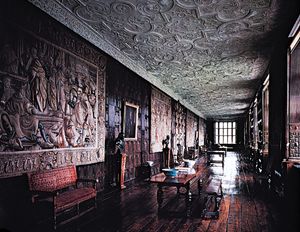Jacobean age
Our editors will review what you’ve submitted and determine whether to revise the article.
- Date:
- 1603 - 1625
- Significant Works:
- King James Version
- Related Artists:
- William Shakespeare
- Francis Bacon
- John Donne
- Ben Jonson
- Inigo Jones
Jacobean age, (from Latin Jacobus, “James”), period of visual and literary arts during the reign of James I of England (1603–25). The distinctions between the early Jacobean and the preceding Elizabethan styles are subtle ones, often merely a question of degree, for although the dynasty changed, there was no distinct stylistic transition.
In architecture the Jacobean age is characterized by a combination of motifs from the late Perpendicular Gothic period with clumsy and imperfectly understood classical details, in which the influence of Flanders was strong. The Tudor pointed arch is common, and in interior work there is considerable simple Tudor paneling and an occasional use of Perpendicular vaulting forms. Doorways, fireplaces, and the like are usually framed with classical forms, and both outside and inside there is a wide use of terms, pilasters, S-scrolls, and the type of pierced, flat ornament known as strapwork. Jacobean furniture pieces are usually of oak and are notable for their heavy forms and bulbous legs. It was during the Jacobean period, however, that the designer Inigo Jones introduced the first fully realized Renaissance classical style of architecture into England with his design of the Banqueting House, Whitehall (1619–22). Jones’s style was based on the theories and works of Andrea Palladio, and Palladianism subsequently became a widely adopted architectural style in England.
During this period, painting and sculpture lagged behind architecture in accomplishments because there was no outstanding practitioner of either. The chief of the early Jacobean painters was the talented miniaturist Isaac Oliver. Most of the Jacobean portraitists, like the sculptors, were foreign-born or foreign-influenced—for example, Marcus Gheerhaerts the Younger, Paul van Somer, Cornelius Johnson, and Daniel Mytens. Their efforts were later surpassed by those of the Flemish painters Peter Paul Rubens and Anthony Van Dyck, who worked in England during the reign of Charles I.
In literature, too, many themes and patterns were carried over from the preceding Elizabethan era. Though rich, Jacobean literature is often darkly questioning. William Shakespeare’s greatest tragedies were written between about 1601 and 1607. Other Jacobean dramatic writers became preoccupied with the problem of evil: the plays of John Webster, John Marston, Thomas Middleton, and George Chapman induce all the terror of tragedy but little of its pity. Comedy was best represented by the acid satire of Ben Jonson and by the varied works of Francis Beaumont and John Fletcher. Another feature of drama at this time, however, was the development of the extravagant courtly entertainment known as the masque, which reached its literary peak in the works of Jonson and Inigo Jones. Jonson’s comparatively lucid and graceful verse and the writings of his Cavalier successors constituted one of the two main streams of Jacobean poetry. The other poetic stream lay in the intellectual complexity of John Donne and the Metaphysical poets. In prose, Francis Bacon and Robert Burton were among the writers who displayed a new toughness and flexibility of style. The monumental prose achievement of the era was the great King James Version of the Bible, which first appeared in 1611.






















